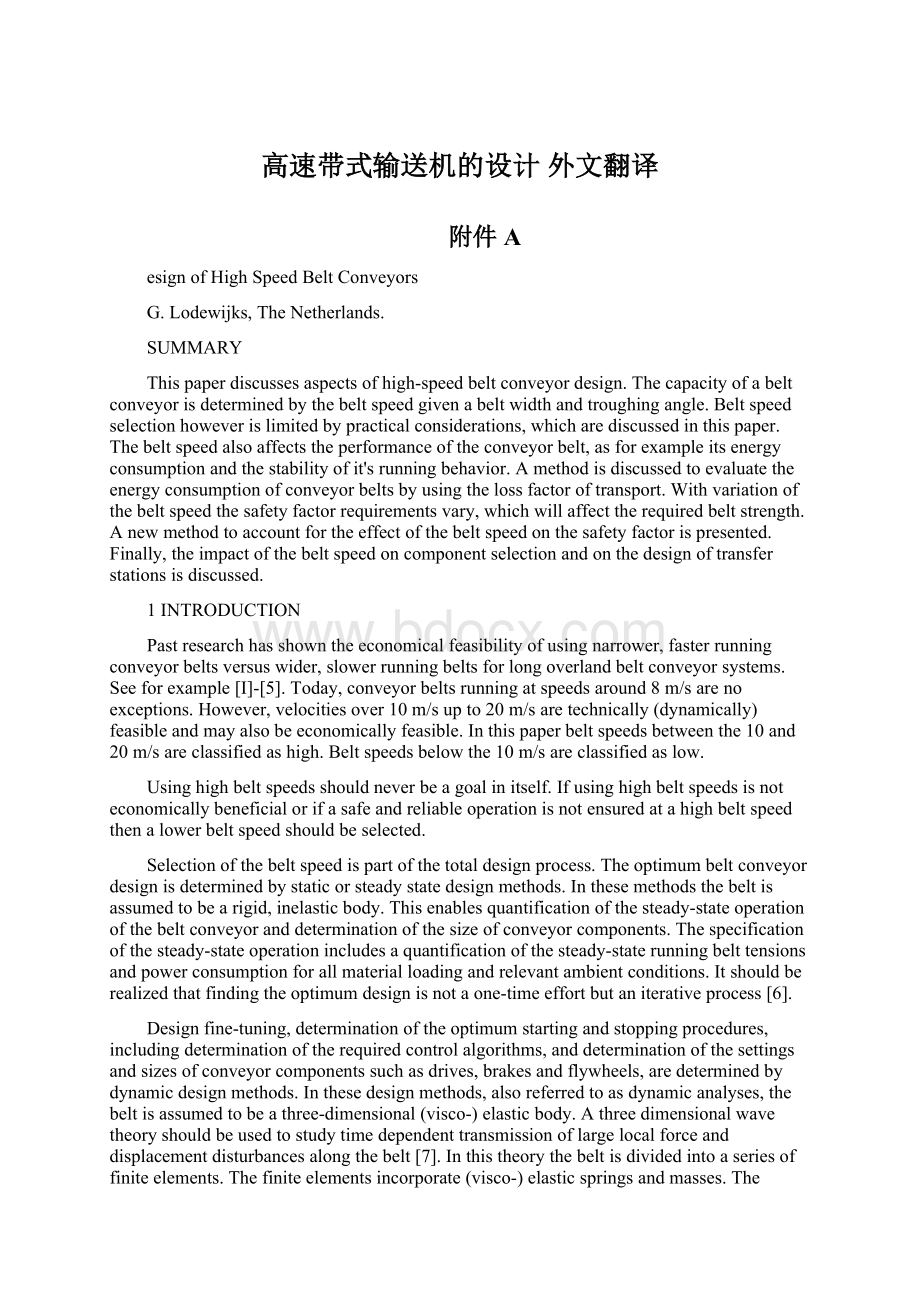高速带式输送机的设计 外文翻译.docx
《高速带式输送机的设计 外文翻译.docx》由会员分享,可在线阅读,更多相关《高速带式输送机的设计 外文翻译.docx(23页珍藏版)》请在冰豆网上搜索。

高速带式输送机的设计外文翻译
附件A
esignofHighSpeedBeltConveyors
G.Lodewijks,TheNetherlands.
SUMMARY
Thispaperdiscussesaspectsofhigh-speedbeltconveyordesign.Thecapacityofabeltconveyorisdeterminedbythebeltspeedgivenabeltwidthandtroughingangle.Beltspeedselectionhoweverislimitedbypracticalconsiderations,whicharediscussedinthispaper.Thebeltspeedalsoaffectstheperformanceoftheconveyorbelt,asforexampleitsenergyconsumptionandthestabilityofit'srunningbehavior.Amethodisdiscussedtoevaluatetheenergyconsumptionofconveyorbeltsbyusingthelossfactoroftransport.Withvariationofthebeltspeedthesafetyfactorrequirementsvary,whichwillaffecttherequiredbeltstrength.Anewmethodtoaccountfortheeffectofthebeltspeedonthesafetyfactorispresented.Finally,theimpactofthebeltspeedoncomponentselectionandonthedesignoftransferstationsisdiscussed.
1INTRODUCTION
Pastresearchhasshowntheeconomicalfeasibilityofusingnarrower,fasterrunningconveyorbeltsversuswider,slowerrunningbeltsforlongoverlandbeltconveyorsystems.Seeforexample[I]-[5].Today,conveyorbeltsrunningatspeedsaround8m/sarenoexceptions.However,velocitiesover10m/supto20m/saretechnically(dynamically)feasibleandmayalsobeeconomicallyfeasible.Inthispaperbeltspeedsbetweenthe10and20m/sareclassifiedashigh.Beltspeedsbelowthe10m/sareclassifiedaslow.
Usinghighbeltspeedsshouldneverbeagoalinitself.Ifusinghighbeltspeedsisnoteconomicallybeneficialorifasafeandreliableoperationisnotensuredatahighbeltspeedthenalowerbeltspeedshouldbeselected.
Selectionofthebeltspeedispartofthetotaldesignprocess.Theoptimumbeltconveyordesignisdeterminedbystaticorsteadystatedesignmethods.Inthesemethodsthebeltisassumedtobearigid,inelasticbody.Thisenablesquantificationofthesteady-stateoperationofthebeltconveyoranddeterminationofthesizeofconveyorcomponents.Thespecificationofthesteady-stateoperationincludesaquantificationofthesteady-staterunningbelttensionsandpowerconsumptionforallmaterialloadingandrelevantambientconditions.Itshouldberealizedthatfindingtheoptimumdesignisnotaone-timeeffortbutaniterativeprocess[6].
Designfine-tuning,determinationoftheoptimumstartingandstoppingprocedures,includingdeterminationoftherequiredcontrolalgorithms,anddeterminationofthesettingsandsizesofconveyorcomponentssuchasdrives,brakesandflywheels,aredeterminedbydynamicdesignmethods.Inthesedesignmethods,alsoreferredtoasdynamicanalyses,thebeltisassumedtobeathree-dimensional(visco-)elasticbody.Athreedimensionalwavetheoryshouldbeusedtostudytimedependenttransmissionoflargelocalforceanddisplacementdisturbancesalongthebelt[7].Inthistheorythebeltisdividedintoaseriesoffiniteelements.Thefiniteelementsincorporate(visco-)elasticspringsandmasses.Theconstitutivecharacteristicsofthefiniteelementsmustrepresenttherheologicalcharacteristicsofthebelt.Dynamicanalysisproducesthebelttensionandpowerconsumptionduringnon-stationaryoperation,likestartingandstopping,ofthebeltconveyor.
Thispaperdiscussesthedesignofhighbelt-speedconveyors,inparticulartheimpactofusinghighbeltspeedsontheperformanceoftheconveyorbeltintermsofenergyconsumptionandsafetyfactorrequirements.Usinghighbeltspeedsalsorequireshighreliabilityofconveyorcomponentssuchasidlerstoachieveanacceptablecomponentlife.Anotherimportantaspectofhigh-speedbeltconveyordesignisthedesignofefficientfeedinganddischargearrangements.Theseaspectswillbediscussedbriefly.
2BELTSPEED
2.1BELTSPEEDSELECTION
Thelowestoverallbeltconveyorcostoccurintherangeofbeltwidthsof0.6to1.0m[2].Therequiredconveyingcapacitycanbereachedbyselectionofabeltwidthinthisrangeandselectingwhateverbeltspeedisrequiredtoachievetherequiredflowrate.Figure1showsanexampleofcombinationsofbeltspeedandbeltwidthtoachieveSpecificconveyorcapacities.Inthisexampleitisassumedthatthebulkdensityis850kg/m3(coal)andthatthetroughangleandthesurchargeangleare35'and20'respectively.
Figure1:
Beltwidthversusbeltspeedfordifferentcapacities.
Beltspeedselectionishoweverlimitedbypracticalconsiderations.Afirstaspectisthetroughabilityofthebelt.InFigure1thereisnorelationwiththerequiredbeltstrength(rating),whichpartlydependsontheconveyorlengthandelevation.Thecombinationofbeltwidthandstrengthmustbechosensuchthatgoodtroughabilityofthebeltisensured.Ifthetroughabilityisnotsufficientthenthebeltwillnottrackproperly.Thiswillresultinunstablerunningbehaviorofthebelt,inparticularathighbeltspeeds,whichisnotacceptable.Normally,beltmanufacturersexpectasufficientlystraightrunifapproximately40%ofthebeltwidthwhenrunningempty,makescontactwiththecarryingidlers.Approximately10%shouldmaketangentialcontactwiththecenteridlerroll.
Asecondaspectisthespeedoftheairrelativetothespeedofthebulksolidmaterialonthebelt(relativeairspeed).Iftherelativeairspeedexceedscertainlimitsthendustwilldevelop.Thisisinparticularapotentialprobleminmineshaftswhereadownwardairflowismaintainedforventilationpurposes.Thelimitinrelativeairspeeddependsonambientconditionsandbulkmaterialcharacteristics.
Athirdaspectisthenoisegeneratedbythebeltconveyorsystem.Noiselevelsgenerallyincreasewithincreasingbeltspeed.Inresidentialareasnoiselevelsarerestrictedtoforexample65dB.Althoughnoiselevelsaregreatlyaffectedbythedesignoftheconveyorsupportstructureandconveyorcovers,thismaybealimitingfactorinselectingthebeltspeed.
2.2BELTSPEEDVARIATION
Theenergyconsumptionofbeltconveyorsystemsvarieswithvariationofthebeltspeed,aswillbeshowninSection3.Thebeltvelocitycanbeadjustedwithbulkmaterialflowsuppliedattheloadingpointtosaveenergy.Ifthebeltisoperatingatfulltonnagethenitshouldrunatthehigh(design)beltspeed.Thebeltspeedcanbeadjusted(decreased)totheactualmaterial(volume)flowsuppliedattheloadingpoint.Thiswillmaintainaconstantfillingofthebelttroughandaconstantbulkmaterialloadonthebelt.Aconstantfillingofthebelttroughyieldsanoptimumloading-ratio,andlowerenergyconsumptionperunitofconveyedmaterialmaybeexpected.Thereductioninenergyconsumptionwillbeatleast10%forsystemswherethebeltspeedisvariedcomparedtosystemswherethebeltspeediskeptconstant[8].
Varyingthebeltspeedwithsuppliedbulkmaterialflowhasthefollowingadvantages:
∙Lessbeltwearattheloadingareas
∙Lowernoiseemission
∙Improvedoperatingbehaviorasaresultofbetterbeltalignmentandtheavoidanceofbeltliftinginconcavecurvebyreducingbelttensions
Drawbacksinclude:
∙Investmentcostforcontrollabilityofthedriveandbrakesystems
∙Variationofdischargeparabolawithbeltspeedvariation
∙Controlsystemrequiredforcontrollingindividualconveyorsinaconveyorsystem
∙Constanthighbeltpre-tension
∙Constanthighbulkmaterialloadontheidlerrolls
Ananalysisshouldbemadeoftheexpectedenergysavingstodeterminewhetheritisworththeeffortofinstallingamoreexpensive,morecomplexconveyorsystem.
3ENERGYCONSUMPTION
Clientsmayrequestaspecificationoftheenergyconsumptionofaconveyorsystem,forexamplequantifiedintermsofmaximumkW-hr/ton/km,totransportthebulksolidmaterialatthedesignspecificationsovertheprojectedroute.Forlongoverlandsystems,theenergyconsumptionismainlydeterminedbytheworkdonetoovercometheindentationrollingresistance[9].Thisistheresistancethatthebeltexperiencesduetothevisco-elastic(timedelayed)responseoftherubberbeltcovertotheindentationoftheidlerroll.Forin-plantbeltconveyors,workdonetoovercomesideresistancesthatoccurmainlyintheloadingareaalsoaffectstheenergyconsumption.Sideresistancesincludetheresistanceduetofrictiononthesidewallsofthechuteandresistancethatoccursduetoaccelerationofthematerialattheloadingpoint.
Therequireddrivepowerofabeltconveyorisdeterminedbythesumofthetotalfrictionalresistancesandthetotalmateriallift.Thefrictionalresistancesincludehysteresislosses,whichcanbeconsideredasviscous(velocitydependent)frictioncomponents.Itdoesnotsufficetolookjustatthemaximumrequireddrivepowertoevaluatewhetherornottheenergyconsumptionofaconveyorsystemisreasonable.Thebestmethodtocomparetheenergyconsumptionofdifferenttransportsystemsistocomparetheirtransportefficiencies.
3.1TRANSPORTEFFICIENCY
Thereareanumberofmethodstocomparetransportefficiencies.ThefirstandmostwidelyappliedmethodistocompareequivalentfrictionfactorssuchastheDINffactor.Anadvantageofusinganequivalentfrictionfactoristhatitcanalsobedeterminedforanemptybelt.Adrawbackofusinganequivalentfrictionfactoristhatitisnota'pure'efficiencynumber.Ittakesintoaccountthemassofthebelt,reducedmassoftherollersandthemassofthetransportedmaterial.Inapureefficiencynumber,onlythemassofthetransportedmaterialistakenintoaccount.
Thesecondmethodistocomparetransportationcost,eitherinkW-hr/ton/kmorin$/ton/km.Theadvantageofusingthetransportationcostisthatthisnumberiswidelyusedformanagementpurposes.Thedisadvantageof